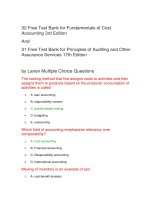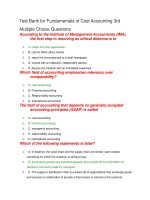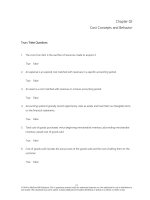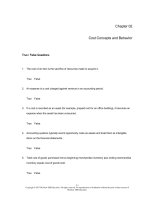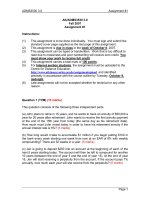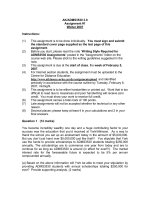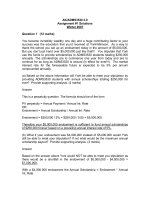120 test bank for fundamentals of cost accounting 4th edition
Bạn đang xem bản rút gọn của tài liệu. Xem và tải ngay bản đầy đủ của tài liệu tại đây (167.43 KB, 31 trang )
120 Test Bank for Fundamentals of Cost Accounting 4th
Edition
True-False Questions
Cost accounting information developed for managers to use in
making decisions must comply with generally accepted
accounting principles (GAAP) and international financial
reporting standards (IFRS).
1.
True
2.
False
Cost accounting plays a significant role in management
decision making.
1.
True
2.
False
Financial accounting receives information only from cost
accounting activity.
1.
True
2.
False
The Value chain is comprised of the activities that take place
during the production process.
1.
True
2.
False
Administrative functions are not included as part of the value
chain because they are implicitly included in every
business function.
1.
True
2.
False
Cost accounting information can be used by managers to
defraud customers, creditors, and owners.
1.
True
2.
False
A cost driver is a factor that causes costs.
1.
True
2.
False
Activity-based costing (ABC) is a management tool that focuses
on the continuous improvement of all dimensions of a
business.
1.
True
2.
False
Cost accounting is broader in scope than financial accounting.
1.
True
2.
False
Financial accounting information is designed for decisionmakers who are directly involved in the daily management
of the firm.
1.
True
2.
False
Financial accounting provides financial and nonfinancial
information that helps managers in the decision making
process.
1.
True
2.
False
Budgeting is primarily used to determine year-end bonuses
based on managerial and organizational performance.
1.
True
2.
False
A responsibility center can be a department, division, or
segment, but not a subsidiary of the parent company.
1.
True
2.
False
A cost can be considered a differential cost for one particular
course of action but not for another course of action.
1.
True
2.
False
The value chain comprises activities from research and
development through the production process, but does
not include activities related to the distribution of
products or services.
1.
True
2.
False
Ethical behavior depends more on a firm's code of conduct than
the individual's personal beliefs.
1.
True
2.
False
Under the value chain concept, instead of perceiving whether
individual activities in the chain add value, customers
only consider the overall utility of the goods or services
they purchase.
1.
True
2.
False
A value chain consists of the major subassemblies that add
value to a product.
1.
True
2.
False
It is more important for financial accounting information to be
comparable between firms than to be useful for
managerial decision-making.
1.
True
2.
False
It is important that the manager assigned to lead a
responsibility center be held accountable for its
operations.
1.
True
2.
False
Cost data can be used for one managerial decision but not for
another managerial decision.
1.
True
2.
False
Managers are usually responsible for the revenues needed to
achieve the targets set during the budgeting process, but
not the resources consumed to achieve those targets.
1.
True
2.
False
Customer satisfaction is an example of a non-financial
performance measure.
1.
True
2.
False
A person who makes unethical decisions in their personal life is
likely to make unethical decisions in their professional
life.
1.
True
2.
False
The lean thinking model focuses on reducing defects to as
close to zero as possible.
1.
True
2.
False
Managers face ethical situations on a daily basis, while
accountants face them infrequently.
1.
True
2.
False
Cost accounting provides information only for cost accounting
purposes.
1.
True
2.
False
Benchmarking is a continuous process of measuring a
company's products, services, or activities against
competitors' performance.
1.
True
2.
False
Mutiple Choice Questions- Page 1
During 2013, the JKL Restaurant had sales revenues and food
costs of $800,000 and $600,000,respectively. During 2014,
JKL plans to introduce a new menu item that is expected
to increase sales revenues by $100,000 and food costs by
$40,000. Assuming no changes are expected for the other
food items, operating profits for 2013 are expected to
increase by.
1.
A. $260,000.
2.
B. $100,000.
3.
C. $60,000.
4.
D. $40,000.
Information technology that links the various processes of the
company into a single comprehensive information system
is called
1.
A. customer relationship management.
2.
B. distribution chain.
3.
C. total quality management.
4.
D. cost of quality.
5.
E. enterprise resource planning.
(CIA adapted) The primary reason for adopting total quality
management (TQM) is to achieve
1.
A. reduced delivery time.
2.
B. reduced delivery charges.
3.
C. greater customer satisfaction.
4.
D. greater employee participation.
5.
E. better managerial decisions.
(CMA adapted) An accounting system that collects financial and
operating data on the basis of the underlying nature and
extent of cost drivers is
1.
A. full-absorption costing.
2.
B. activity-based costing.
3.
C. variable costing.
4.
D. benchmarking.
The costing method that first assigns costs to activities and
then assigns them to products based on the products'
consumption of activities is called
1.
A. lean accounting.
2.
B. responsibility centers.
3.
C. activity-based costing.
4.
D. budgeting.
5.
E. outsourcing.
(CMA adapted) Cost drivers are
1.
A. activities that cause costs to increase as the activity increases.
2.
B. accounting techniques and practices used to control costs.
3.
C. accounting reimbursements used to evaluate whether performance is proceeding
according to plan.
4.
D. a mechanical basis, such as machine hours, computer time, or factory square
footage, used to assign costs to activities.
Which field of accounting emphasizes relevancy over
comparability?
1.
A. Cost accounting
2.
B. Financial accounting
3.
C. Responsibility accounting
4.
D. International accounting
(CMA adapted) The process of creating a formal plan and
translating goals into a quantitative format is referred to
as
1.
A. budgeting.
2.
B. benchmarking.
3.
C. cost-benefit analysis.
4.
D. value-added analysis.
5.
E. activity-based costing.
Which of the following is not one of the overarching ethical
principles of the Institute of Management Accountants
(IMA) Code of Ethics?
1.
A. Competence
2.
B. Responsibility
3.
C. Honesty
4.
D. Objectivity
5.
E. Fairness
According to the Institute of Management Accountants (IMA),
the final step in resolving an ethical dilemma is to
1.
A. resign from the organization.
2.
B. call the IMA's ethics hotline.
3.
C. report the circumstances to a local newspaper.
4.
D. consult with an objective, independent advisor.
5.
E. discuss the situation with an immediate supervisor.
The system that allows firms to target profitable customers by
assessing customer revenue and costs is called
1.
A. customer relationship management.
2.
B. distribution chain.
3.
C. total quality management.
4.
D. cost of quality.
5.
E. enterprise resource planning.
The financial plan of the revenues and resources needed to
carry out activities and meet financial goals is called
1.
A. performance measure.
2.
B. benchmarking.
3.
C. budgeting.
4.
D. responsibility center.
5.
E. lean accounting.
The just-in-time (JIT) method of production focuses on
1.
A. increasing sales revenue.
2.
B. reducing inventories.
3.
C. increasing customer service.
4.
D. reducing operating expenses.
5.
E. increasing product quality.
The set of activities that transforms raw resources into the
goods and services of an organization is called:
1.
A. Value chain.
2.
B. Supply chain.
3.
C. Demand chain.
4.
D. Cost-benefit analysis.
The field of accounting that depends on generally accepted
accounting principles (GAAP) is called
1.
A. cost accounting.
2.
B. financial accounting.
3.
C. managerial accounting.
4.
D. responsibility accounting.
5.
E. international accounting.
Which of the following is a nonvalue-added activity?
1.
A. Product design
2.
B. Customer service
3.
C. Research and development
4.
D. Rework of defective items
The system that identifies the costs of producing low-quality
items is called
1.
A. customer relationship management.
2.
B. distribution chain.
3.
C. total quality management.
4.
D. cost of quality.
5.
E. enterprise resource planning.
The cost accounting system that minimizes wasteful or
unnecessary transaction processes is
1.
A. performance measure.
2.
B. benchmarking.
3.
C. budgeting.
4.
D. responsibility center.
5.
E. lean accounting.
Which of the following statements is false?
1.
A. In essence, the value chain and the supply chain are similar; each creates
something for which the customer is willing to pay.
2.
B. Accounting systems are important because they provide all the information for
decisions commonly made by managers.
3.
C. The supply or distribution chain is a linked set of organizations that exchange goods
and services in combination to provide a final product or service to the customer.
4.
D. Eliminating nonvalue-added activities always reduces costs without affecting the
value of the product to customers.
Which of the following is not one of the basic standards of the
Institute of Management Accountants (IMA) Code of
Ethics?
1.
A. Competence
2.
B. Confidentiality
3.
C. Honesty
4.
D. Integrity
5.
E. Credibility
Managers do not make decisions about future events based
on:
1.
A. Perfect information.
2.
B. Estimated information.
3.
C. Actual information.
4.
D. Financial information.
According to the Institute of Management Accountants (IMA),
the first step in resolving an ethical dilemma is to
1.
A. resign from the organization.
2.
B. call the IMA's ethics hotline.
3.
C. report the circumstances to a local newspaper.
4.
D. consult with an objective, independent advisor.
5.
E. discuss the situation with an immediate supervisor.
Continual process of measuring a company's own products,
services or activities against competitors' performance is
1.
A. performance measure.
2.
B. benchmarking.
3.
C. budgeting.
4.
D. responsibility center.
5.
E. lean accounting.
Which of the following activities would not be considered a
value-added activity?
1.
A. Production
2.
B. Marketing
3.
C. Accounting
4.
D. Distribution
Having one or more of the firms' activities performed by
another firm or individual in the supply or distribution
chain is called
1.
A. lean accounting.
2.
B. responsibility centers.
3.
C. activity-based costing.
4.
D. budgeting.
5.
E. outsourcing
85 Free Test Bank for Fundamentals of Cost Accounting
4th Edition by Lanen Mutiple Choice QuestionsPage 2
Financial accounting provides a historical perspective, while
cost accounting emphasizes
1.
A. reporting to stockholders.
2.
B. a current perspective.
3.
C. the future.
4.
D. past transactions.
Which of the following activities would not be included in the
value chain of a manufacturing company?
1.
A. Research and Development
2.
B. Customer Service
3.
C. Design
4.
D. Accounting
Manufacturing firms use the value chain to take steps to
improve the overall profitability of the firm by:
1.
A. placing greater emphasis on the value chain.
2.
B. moving to an emphasis on upstream activities in the value chain.
3.
C. moving to an emphasis on downstream activities in the value chain.
4.
D. finding low-cost manufacturing locations.
Which of the following is not a key financial manager in an
organization?
1.
A. Chief financial officer
2.
B. Treasurer
3.
C. External auditor
4.
D. Controller
5.
E. Cost accountant
Which of the following is not normally considered part of the
value chain?
1.
A. Research and development
2.
B. Purchasing
3.
C. Administration
4.
D. Distribution
5.
E. Customer service.
The financial accounting system is the primary source of
information for
1.
A. decision making on the factory floor.
2.
B. improving the performance level of customer service.
3.
C. planning the budget for next year.
4.
D. preparing the income statement for stockholders.
The extended value chain:
1.
A. is a set of consecutive operations or processes that begins with purchasing
resources and ends with providing products or services that customers value.
2.
B. is a related set of tasks, manual or automated, that transforms inputs into identifiable
outputs.
3.
C. incorporates how companies obtain their resources and distribute their products and
services,using the services of other organizations.
4.
D. is a technique for identifying opportunities for improvement and measuring the
effects of proposed improvements by comparing both the costs and benefits of a
proposal.
The individual who would most likely use only financial
accounting information in making decisions is a
1.
A. vice president of marketing.
2.
B. factory supervisor.
3.
C. department manager.
4.
D. company stockholder.
During which step of the value chain process will a
manufacturing company determine whether or not it has
added utility?
1.
A. The Design component
2.
B. The Purchasing process
3.
C. The Production activity
4.
D. Added utility occurs in all steps.
The value chain is the order of business components in which:
1.
A. value is deducted from the products or services of a business.
2.
B. value is proportionally added to the products or services of a business.
3.
C. products or services are evaluated according to their value to the distribution chain.
4.
D. utility is added to the products or services of an organization.
Financial accounting
1.
A. focuses on the future.
2.
B. must comply with GAAP (generally accepted accounting principles).
3.
C. reports include detailed information on the various operating segments of the
business.
4.
D. is prepared for the use of management.
Surf Boards, Inc. had the following summarized results for the
month ending July 30: Revenus: $69,000(Actual),
$52,000(Budget); costs:$53,600(Actual),$45,600(Budget);
operating profits:$6,400(Actual),$6,400(Budget) Assume
that the budget was based on the sale of 104 surfboards
at $500 each and the actual results reflect the sale of 104
surfboards. What is the most appropriate conclusion in
the report to management?
1.
A. If costs as a percentage of revenues had remained at the budgeted level, net
income would have declined.
2.
B. If costs as a percentage of revenues remain at the actual level any increase in
revenues would probably be matched by a decrease in net income.
3.
C. If costs as a percentage of revenues had remained at the budgeted level, net
income would be $985 above budget.
4.
D. If costs as a percentage of revenues had remained at the budgeted levels, net
income would be $4,000 above budget.
In 2013, the Turnkey Company had consulting revenues of
$1,000,000 while costs were $750,000. In 2014, Turnkey
will be introducing a new service that will generate
$150,000 in sales revenues and $60,000 in costs.
Assuming no changes are expected for the other
services,operating profits are expected to increase by
1.
A. $250,000.
2.
B. $150,000.
3.
C. $90,000.
4.
D. $60,000.
Cost accounting provides all of the following with the exception
of
1.
A. pricing information from marketing studies.
2.
B. nonfinancial information regarding the cost of operational efficiencies.
3.
C. financial information on the cost of acquiring resources.
4.
D. information for managerial accounting and financial accounting.
The primary objective of financial accounting is
1.
A. profitability analysis.
2.
B. providing information for management decision making.
3.
C. cost planning and cost controls.
4.
D. reporting to investors, creditors, and government authorities.
Surf Boards, Inc. had the following summarized results for the
month ending July 30: Revenus: $69,000(Actual),
$52,000(Budget);costs:$53,600(Actual),$45,600(Budget);
operating profits:$6,400(Actual),$6,400(Budget) As the
cost accountant, which single note to the above financial
results is most appropriate in the report to management?
1.
A. The departmental manager is performing to expectations because budgeted income
equals actual income.
2.
B. Revenues are above budget and a bonus based on this increase should be
considered.
3.
C. Costs as a percentage of revenues are above budget and a further scrutiny of the
results might be appropriate.
4.
D. Costs are 17.5% above budget and the department manager's position should be
critically evaluated by senior management.
A management method by which the organization seeks to
excel on all dimensions of quality is called
1.
A. customer relationship management.
2.
B. distribution chain.
3.
C. total quality management.
4.
D. cost of quality.
5.
E. enterprise resource planning.
Costs that change in response to a particular course of action
are
1.
A. differential costs.
2.
B. cost-benefit analysis.
3.
C. activity-based costs
4.
D. cost drivers.
Which of the following statements concerning the value chain
is false?
1.
A. The goal of a value chain is to find areas where a company can either add value or
reduce cost.
2.
B. The value chain focuses on the entire production process, as well as the sale of the
product and service after the sale.
3.
C. If a company cannot compete in a specific area of the value chain, it might
outsource that portion of the value chain to another entity which can perform it better.
4.
D. Successful firms are ones that operate within the entire value chain, thereby
overseeing every aspect of the value chain for the customer.
A firm's replies to customers' questions via email would be an
example of which element of the value chain?
1.
A. Customer Service
2.
B. Marketing
3.
C. Design
4.
D. Supply
In 2013, the MoreForLess Company had revenues of $2,000,000
and costs of $1,500,000. During 2014, MoreForLess will be
introducing a new product line that is expected to
increase sales revenue by $200,000 and costs by
$160,000. Assuming no changes are expected for the
other products, the operating profits are expected to
increase by
1.
A. $540,000.
2.
B. $200,000.
3.
C. $160,000.
4.
D. $40,000.
Which of the following could be considered part of the value
chain in a service firm?
1.
A. Inspection of product
2.
B. Advertising
3.
C. Raw materials
4.
D. Distribution
Place the four components in the order they appear along the
value chain: A = Customer service; B = Design; C =
Distribution; and D = Production.
1.
A. ABDC
2.
B. ACDB
3.
C. BDCA
4.
D. BADC
Which of the following does not represent a main focus of cost
management information?
1.
A. Internal auditing and control
2.
B. Performance measurement
3.
C. Planning and decision making
4.
D. Preparation of financial statements
Which of the following types of organizations can most benefit
from the implementation of value chain?
1.
A. Service firms
2.
B. Not-for-profit organizations
3.
C. Manufacturing firm.
4.
D. All types of organizations can benefit from the implementation of value chain
The delivery of products or services to customers is an example
of which element in the value chain?
1.
A. Production
2.
B. Design
3.
C. Marketing
4.
D. Distribution
Moving of inventory is an example of a(n)
1.
A. cost-benefit analysis.
2.
B. value-added activity.
3.
C. activity-based cost.
4.
D. nonvalue-added activity.
Cost accounting
1.
A. provides information on material usage.
2.
B. provides information on the profitability of customer orders.
3.
C. provides information on the efficiency of service department labor.
4.
D. All of these.
85 Free Test Bank for Fundamentals of Cost Accounting
4th Edition by Lanen Mutiple Choice QuestionsPage 3
In 2013, the Turnkey Company had consulting revenues of
$1,000,000 while operating costs were $750,000. In 2014,
Turnkey will be introducing a new service that will
generate $150,000 in sales revenues and $60,000 in
operating costs. Assuming no changes are expected for
the other services, the differential revenue for 2014 will be
1.
A. $250,000.
2.
B. $150,000.
3.
C. $90,000.
4.
D. $60,000.
Surf Boards, Inc. had the following summarized results for the
month ending July 30: Revenus: $69,000(Actual),
$52,000(Budget); costs:$53,600(Actual),$45,600(Budget);
operating profits:$6,400(Actual),$6,400(Budget). Assume
that an additional 10 surfboards were sold at the regular
price, during additional store opening hours. What is the
most appropriate conclusion in the report to
management?
1.
A. The budget should be updated to take into account the change.
2.
B. The additional hours were needed, as net income increased.
3.
C. An analysis of the differential costs of the additional store hours should be
undertaken prior to drawing a conclusion as to the success of the change.
4.
D. All of these.
In 2013, the Turnkey Company had consulting revenues of
$1,000,000 while operating costs were $750,000. In 2014,
Turnkey will be introducing a new service that will
generate $150,000 in sales revenues and $60,000 in
operating costs. Assuming no changes are expected for
the other services, the differential operating costs for
2014 will be
1.
A. $250,000.
2.
B. $150,000.
3.
C. $90,000.
4.
D. $60,000.
Where there is a lack of good performance measures, it is
difficult to motivate managers by using
1.
A. performance-based incentives.
2.
B. monetary rewards.
3.
C. compensation.
4.
D. rewards for products.
An Enterprise Resource Planning System can best be
described as
1.
A. a collection of programs that use a variety of unconnected databases.
2.
B. a single database that collects data and feeds it into applications that support each
of the company's business activities, such as purchases, production, distribution, and
sales.
3.
C. a database that is primarily used by a purchasing department to determine the
correct amount of a particular supply item to purchase.
4.
D. a sophisticated means of linking two or more companies to facilitate their planning
processes.
San Juan, Inc. is considering two alternatives: A and B. The
costs associated with the alternatives are listed below: If
only the differential costs of the two decisions are
considered, the total cost of Alternative B is
1.
A. $161,000.
2.
B. $131,500.
3.
C. $59,000.
4.
D. $102,000.
Which of the following cost accounting methods does not help
firms keep the supply chain "lean" and add value
throughout the chain?
1.
A. Target costing
2.
B. Activity-based costing
3.
C. Throughput-costing
4.
D. Performance measures
Al's Brake Shop had sales revenues and operating costs in
2014 of $650,000 and $525,000, respectively. In 2015, Al's
plans to expand the services it provides to customers to
include lubrication services. Revenues are expected to
increase by $85,000 and operating costs by $50,000 as a
result of this expansion. Assuming that there are no
changes to the existing brake business, what is the
amount of operating profits that are expected be earned in
2015?
1.
A. $125,000
2.
B. $85,000
3.
C. $160,000
4.
D. $35,000
Cost leadership can improve on execution through
1.
A. improved automation and a higher output of products.
2.
B. benchmarking and total quality management.
3.
C. cost cutting and downsizing of personnel.
4.
D. improvements in product development.
Two alternatives, identified A and B, are under consideration at
Hayden Corporation. Costs associated with the
alternatives are listed below:Material costs:
$44,000(Alternative A), $56,000(Alternative B);
Proccessing costs:$37,000(Alternative A),
$59,000(Alternative B); Building costs: $14,000(Alternative
A), $14,000(Alternative B); Equipment rental:
$11,000(Alternative A), $11,000(Alternative B). Are the
materials costs and processing costs differential in the
choice between alternatives A and B? (Ignore t
1.
A. Both materials costs and processing costs are differential
2.
B. Only materials costs are differential
3.
C. Only processing costs are differential
4.
D. Neither materials costs nor processing costs are differential
Lucena Corporation purchased a machine 7 years ago for
$339,000 when it launched product X05K. Unfortunately,
this machine has broken down and cannot be repaired.
The machine could be replaced by a new model 360
machine costing $353,000 or by a new model 280 machine
costing $332,000. Management has decided to buy the
model 280 machine. It has less capacity than the model
360 machine, but its capacity is sufficient to continue
making product X05K. Management also considered, but
rejected, the alternative of
1.
A. $21,000.
2.
B. $87,000.
3.
C. $7,000.
4.
D. $14,000.
The approaches and activities of managers in short-run and
long-run planning and control decisions that increase
value for customers and lower costs of products and
services are known as
1.
A. value chain management.
2.
B. enterprise resource planning.
3.
C. cost management.
4.
D. customer value management.
According to the IMA Code of Ethics, what should a
management accountant do if a significant ethical
situation can't be resolved?
1.
A. The accountant should confront the guilty party and demand the unethical action be
stopped.
2.
B. The accountant should try to rationalize and understand the position of the other
party.
3.
C. The accountant should say nothing about the matter until he or she has retired.
4.
D. The accountant should first discuss the matter with the immediate supervisor.
All of the following are examples of total quality management
practices except
1.
A. redesign of a product to reduce its parts by 50 percent.
2.
B. reduction in the movement required in a manufacturing job.
3.
C. separating the sales and services functions.
4.
D. raising raw material quality standards.
The Sarbanes Oxley Act of 2002 requires an effective internal
control system for publicly owned firms. Therefore, with
regards to strategic investment decisions, it is important
that management consider including
1.
A. internal audits of strategic decisions.
2.
B. a code of ethics.
3.
C. a system of preparing and reporting on investment decision.
4.
D. All of these.
Which area(s) of a business can be improved by using a just-intime (JIT) system?
1.
A. Production, purchasing, and delivery
2.
B. Production only
3.
C. Purchasing only
4.
D. Production and purchasing only
The goals and objectives of establishing budgeting in an
organization include all of the following except:
1.
A. the ability to decide whether goals can be achieved.
2.
B. the resources needed to carry out its tasks.
3.
C. anticipated revenues to be generated.
4.
D. the consistent application of generally accepted accounting principles.
All of the following individuals would report to the Chief
Financial Officer (CFO) except the
1.
A. controller.
2.
B. internal auditor.
3.
C. production manager.
4.
D. treasurer.
Two alternatives, identified X and Y, are under consideration at
Hayden Corporation. Costs associated with the
alternatives are listed below:Material costs:
$44,000(Alternative X), $56,000(Alternative Y);
Proccessing costs:$37,000(Alternative X),
$59,000(Alternative Y); Building costs: $14,000(Alternative
X), $14,000(Alternative Y); Equipment rental:
$11,000(Alternative X), $11,000(Alternative Y) What is the
differential cost of Alternative Y over Alternative X?
1.
A. $140,000
2.
B. $123,000
3.
C. $34,000
4.
D. $106,000
The ________ is primarily responsible for cost accounting and
financial accounting.
1.
A. COO (Chief Operating Officer)
2.
B. CIO (Chief Information Officer)
3.
C. treasurer
4.
D. controller
All of the following are examples of total quality management
practices except
1.
A. redesign of a product to reduce its parts by 50 percent.
2.
B. reduction in the movement required in a manufacturing job.
3.
C. separating the sales and services functions.
4.
D. raising raw material quality standards.
Which of the following is a true statement regarding
performance evaluation?
1.
A. Managers should be evaluated on those things over which they have influence.
2.
B. Managers should be evaluated on the performance of the entire organization.
3.
C. Sales personnel do not have complete control over the level of sales.
4.
D. Managers should not be evaluated on those things over which they have influence,
if they do not have complete control over them.
Cost accounting is an integral part of the ________ function in
an organization.
1.
A. treasurer's
2.
B. controller's
3.
C. internal auditor's
4.
D. president's
Al's Brake Shop had sales revenues and operating costs in
2014 of $650,000 and $525,000,respectively. In 2015, Al's
plans to expand the services it provides to customers to
include lubrication services. Revenues are expected to
increase by $85,000 and operating costs by $50,000 as a
result of this expansion. Assuming that there are no
changes to the existing brake business, operating profits
would be expected to increase during 2015 by
1.
A. $125,000.
2.
B. $85,000.
3.
C. $160,000.
4.
D. $35,000.
R&D, production, and customer service are business functions
that are all included as part of
1.
A. the value chain.
2.
B. benchmarking.
3.
C. marketing.
4.
D. the supply chain.
Which of the following is not an ethical standard of competence
in the Standards of Ethical Conduct for Management
Accountants?
1.
A. Development of professional knowledge and skills

